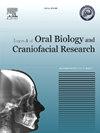Evaluation of bone healing in trabeculae structure of mandibular corpus and angulus fracture patients with fractal dimension analysis
Q1 Medicine
Journal of oral biology and craniofacial research
Pub Date : 2025-01-01
DOI:10.1016/j.jobcr.2024.12.015
引用次数: 0
Abstract
Background
Fractures of the mandibular corpus and angulus are affected by different forces result from different strength of the muscles that influenced them. Therefore, it is presumed that there is a different in healing rate. Fractal dimension radiologic analysis assesses the trabecular pattern, due to it can be used to observe the healing process of bone fractures.
Purpose
The study aimed to compare the healing process of mandibular corpus and angulus fractures with fractal dimension analysis (FD) of trabecular patterns on panoramic radiographs through ImageJ software as consideration to determine mastication loading time.
Methods
This retrospective cross-sectional study observed medical records and panoramic radiographs of patients with a diagnosis of corpus and or mandibular angulus fractures undergoing open reduction (ORIF) 1 plate treatment combined with maxillomandibular fixation (MMF) at Hospital in 2017–2023. Observations were carried out on postoperative 1st day, 2nd week, 8–13th week and >13th week respectively.
Results
Twenty-five subjects who met the inclusion requirements were involved in the study. The results of Two-Way ANOVA statistical test and Fisher's LSD post-hoc showed that the FD values of corpus fracture were significantly greater than that of mandibular angulus with p 0.000 (H1), 0.003 (H2), 0.03 (H3), 0.000 (H4) respectively. In both groups of mandibular corpus and angulus fractures, there was a significant effect of time with p = 0.00 in each group. The longer the observation time, the more trabeculae patterns were formed in the healing process of corpus and angulus fractures.
Conclusion
Post ORIF observation of corpus fracture shows a greater trabecula formation value which indicates faster healing when compared to mandibular angulus fracture.

用分形维数分析评价下颌骨骨小梁结构及骨角骨折患者的骨愈合
背景:下颌骨骨和骨角骨折受到不同力量的影响,这些力量是由影响它们的肌肉的不同力量引起的。因此,可以推测在治愈率上存在差异。分形维数放射学分析评估骨小梁模式,因为它可以用来观察骨折愈合过程。目的通过ImageJ软件对全景x线片上的骨小梁形态进行分形维数分析(FD),比较下颌骨体角骨折的愈合过程,以确定咀嚼加载时间。方法回顾性分析2017-2023年在医院行切开复位(ORIF)钢板联合上颌骨下颌骨固定(MMF)治疗的诊断为体和/下颌角骨折的患者的病历和全景x线片。分别于术后第1天、第2周、第8 - 13周和第13周进行观察。结果符合纳入条件的受试者共25名。双因素方差分析和Fisher’s LSD事后分析结果显示,骨体骨折FD值显著大于下颌角骨折FD值,p值分别为0.000 (H1)、0.003 (H2)、0.03 (H3)、0.000 (H4)。两组下颌骨骨角骨折均受时间影响,p = 0.00。观察时间越长,骨体角骨折愈合过程中形成的小梁模式越多。结论ORIF术后观察,与下颌骨角骨折相比,骨小梁形成值更高,愈合速度更快。
本文章由计算机程序翻译,如有差异,请以英文原文为准。
求助全文
约1分钟内获得全文
求助全文
来源期刊

Journal of oral biology and craniofacial research
Medicine-Otorhinolaryngology
CiteScore
4.90
自引率
0.00%
发文量
133
审稿时长
167 days
期刊介绍:
Journal of Oral Biology and Craniofacial Research (JOBCR)is the official journal of the Craniofacial Research Foundation (CRF). The journal aims to provide a common platform for both clinical and translational research and to promote interdisciplinary sciences in craniofacial region. JOBCR publishes content that includes diseases, injuries and defects in the head, neck, face, jaws and the hard and soft tissues of the mouth and jaws and face region; diagnosis and medical management of diseases specific to the orofacial tissues and of oral manifestations of systemic diseases; studies on identifying populations at risk of oral disease or in need of specific care, and comparing regional, environmental, social, and access similarities and differences in dental care between populations; diseases of the mouth and related structures like salivary glands, temporomandibular joints, facial muscles and perioral skin; biomedical engineering, tissue engineering and stem cells. The journal publishes reviews, commentaries, peer-reviewed original research articles, short communication, and case reports.
 求助内容:
求助内容: 应助结果提醒方式:
应助结果提醒方式:


